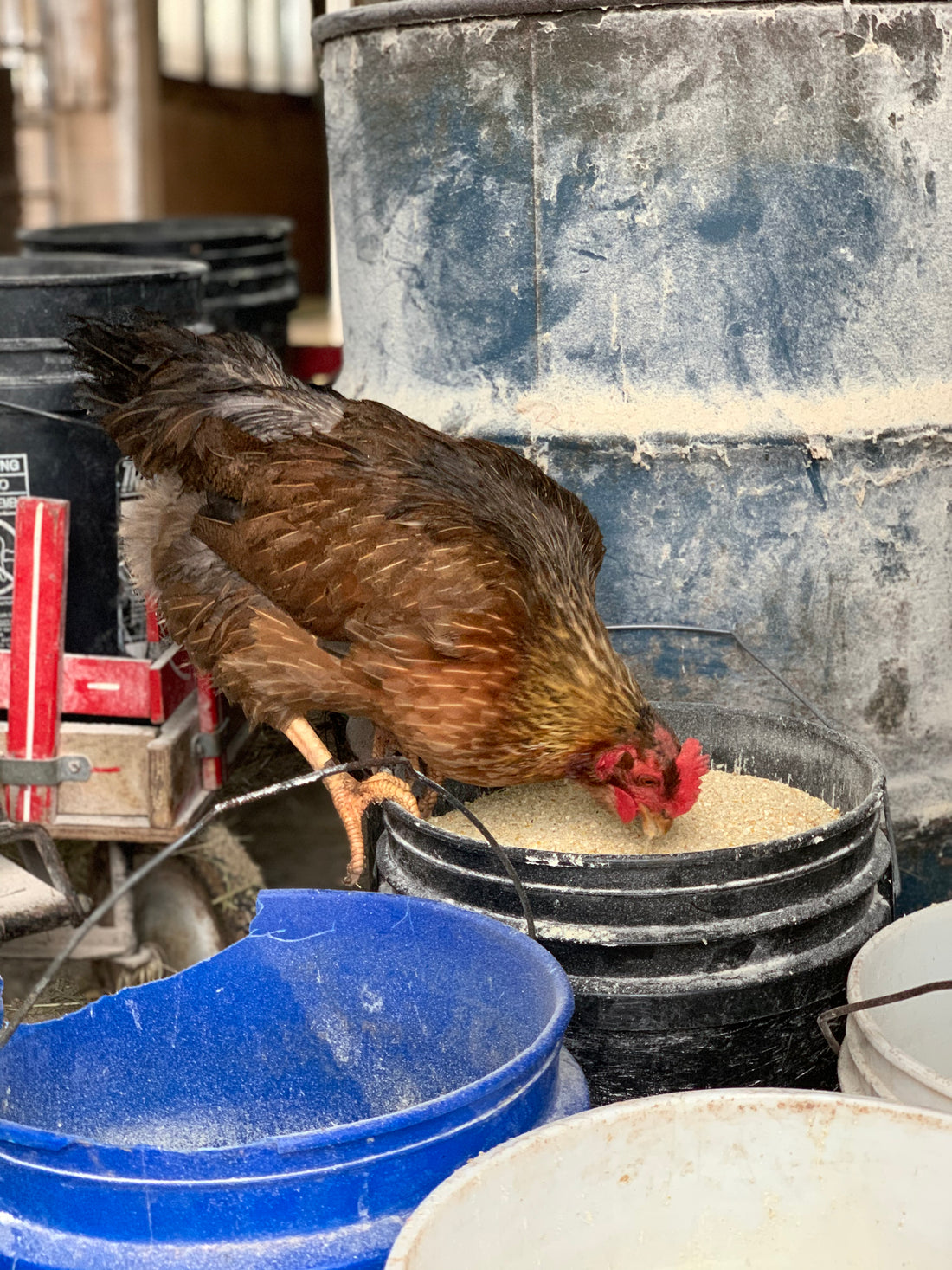A balanced diet is crucial to a chicken’s health and wellbeing. It also plays a very important role in the development of the hen’s ability to lay eggs. The nutritional requirements for a chicken can vary depending on age, breed and even the season. Chicks need a different formulated feed ration than adult birds. Hybrid layers and heritage breed layers will thrive off of different formulated feed rations than one another. Summer feeds should be higher in proteins to support egg development and foraging abilities while winter feeds should be higher in carbohydrates and fats to help birds keep warm. There’s no one-feed-fits-all option when raising chicks to hens so it’s important to understand your chicken’s specific needs as they grow.
 Day old chicks develop quickly. Because of this they require a higher percentage of protein, amino acids and phosphorus in their feed to help create the extra energy they need for growth. Chicks should be fed a finely mashed chick starter that’s balanced to include 20-24% protein. A finely mashed and mixed ration is the preferred feed for a small chick so that their small beaks can pick up and ingest a truly blended and balanced diet. Keeping chicks on this feed through 6 weeks minimum is the ideal time frame until they can be switched to a grower formulated feed. Options for medicated and non-medicated chick feeds are available. Medicated feeds are recommended for chicks that have not been vaccinated for coccidia. Medicated feeds contain Amprolium which is a coccidiostat that helps young chicks develop an immunity to coccidiosis keeping them healthier as they grow into adulthood.
Day old chicks develop quickly. Because of this they require a higher percentage of protein, amino acids and phosphorus in their feed to help create the extra energy they need for growth. Chicks should be fed a finely mashed chick starter that’s balanced to include 20-24% protein. A finely mashed and mixed ration is the preferred feed for a small chick so that their small beaks can pick up and ingest a truly blended and balanced diet. Keeping chicks on this feed through 6 weeks minimum is the ideal time frame until they can be switched to a grower formulated feed. Options for medicated and non-medicated chick feeds are available. Medicated feeds are recommended for chicks that have not been vaccinated for coccidia. Medicated feeds contain Amprolium which is a coccidiostat that helps young chicks develop an immunity to coccidiosis keeping them healthier as they grow into adulthood.  Grower feeds usually contain around 18-20% protein which is the perfect amount to continue supporting the growth of these teenage birds without overwhelming them with unnecessary vitamins and minerals. Transitioning a juvenile bird from starter to layer right away can be dangerous for your bird. Layer feeds contain higher amounts of calcium meant to support the hen’s egg laying abilities. Too much calcium in a young, developing bird can be damaging to their kidneys and also cause disruptions in their reproductive abilities. Sticking to a uniform mashed or crumbled grower feed will provide juvenile chicks the proper balanced diet that supports their growth needs.
Grower feeds usually contain around 18-20% protein which is the perfect amount to continue supporting the growth of these teenage birds without overwhelming them with unnecessary vitamins and minerals. Transitioning a juvenile bird from starter to layer right away can be dangerous for your bird. Layer feeds contain higher amounts of calcium meant to support the hen’s egg laying abilities. Too much calcium in a young, developing bird can be damaging to their kidneys and also cause disruptions in their reproductive abilities. Sticking to a uniform mashed or crumbled grower feed will provide juvenile chicks the proper balanced diet that supports their growth needs.  Strictly foraged diets need lots of land to be successful and must be located in an area where temperatures are more consistent. Supplementing a foraged diet with free-choice layer feed will allow the hen to achieve the proper nutrient intake to maintain optimal health, immunities and production abilities. Layer feeds should be between 15-18% protein and contain higher amounts of calcium to support eggshell development. Two types of layer feed should be considered for your hens throughout a year. One that is given during the summer that’s higher in protein to support egg production and another that is given during the winter months that’s higher in carbohydrates and energy to better support the hen’s ability to maintain their body heat while it’s colder out.
Strictly foraged diets need lots of land to be successful and must be located in an area where temperatures are more consistent. Supplementing a foraged diet with free-choice layer feed will allow the hen to achieve the proper nutrient intake to maintain optimal health, immunities and production abilities. Layer feeds should be between 15-18% protein and contain higher amounts of calcium to support eggshell development. Two types of layer feed should be considered for your hens throughout a year. One that is given during the summer that’s higher in protein to support egg production and another that is given during the winter months that’s higher in carbohydrates and energy to better support the hen’s ability to maintain their body heat while it’s colder out. 
